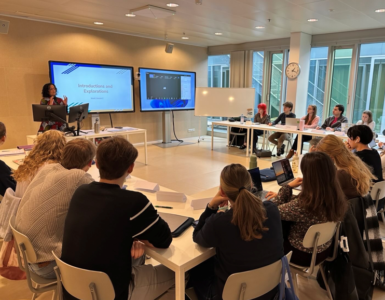In 2020, I alongside fellow teachers, suddenly shifted from face-to-face to online teaching as a result of Covid-19. Online teaching is not new but pedagogy in the online environment is still an underdeveloped field and is challenging for many teachers like me. How did I get on? Well it was with mixed success and I would like to share the three lessons that I learnt in this short article.
I teach language development and methodology to Hungarian primary teacher trainees at a Hungarian university. I adopted a flipped learning pedagogy to teach online. In flipped learning the traditional classroom model is reversed. Traditionally students learn subject matter in the lesson, then after the lesson do homework to consolidate that input. But in flipped learning students study subject matter by themselves before the lesson through video, audio or text-based input and in the lesson do student-student collaborative activities like problem-solving tasks, to consolidate that input (Flipped Learning Network, 2014).
I incorporated ten online activities into my courses and used the Moodle platform to store self-study materials. For live lessons I used Zoom because Zoom’s breakout rooms let me put students into groups for the collaboration central to flipped learning.
The ten activities
- Recorded lectures: Pre-lesson, students watched teacher-made recorded lectures about specific subject matter
- Zoom whole class: Students and I discussed the contents of the recorded lectures
- External sites: Students worked from websites
- Zoom 1-to-1: I held individual tutorials
- Zoom pair work: Student-student collaboration in pairs/groups to consolidate input from recorded lectures
- Videos: Pre-lesson students watched course-related, professionally-produced videos
- Student presentations: Students gave mini presentations
- Games: Students learnt through game apps
- Forum: Students contributed to written online discussions/collaborated on problem-solving tasks on Moodle’s Forum
- Self-study: Students completed teacher-made self-study materials.
To understand which of these activities helped or hindered learning, I asked 32 students to assess each activity’s effectiveness. They awarded marks of 1-5 in response to the question ‘Did this activity help improve your English language/understanding of course content?’. Mark 5 represented 100% effectiveness, mark 4 75% effectiveness, marks 3, 2 and 1 represented 50%, 25% and 0% respectively.
The chart below shows the students’ feedback. Each column corresponds to a mark. Light blue represents mark 5, orange mark 4 and so on. Thus for ‘Recorded lectures’, 84% of students awarded mark 5 (100% effective) and 16%, mark 4 (75% effective).

Lessons learnt
1. Develop students’ collaborative skills for flipped learning to work properly
We can see that the two most helpful activities were studying subject matter independently pre-lesson (recorded lectures) then consolidating that input in whole class Zoom lessons. This combination helped them understand and remember new information. Interestingly, ‘Self-study’ without in-class support was ranked least helpful (tenth) suggesting that support in-class is critical for learning. This combination of pre-lesson study plus in-class consolidation partially reflects a flipped pedagogy, implying that for students, flipped learning may well work.
But, students did not value learning through student–student collaboration as indicated by the low rankings for Zoom pair work (fifth) and the Forum (ninth). Most disliked sharing ideas, were afraid of being ridiculed for their ideas or English language mistakes, complained about peers not working equally. However, teacher-directed interaction (‘Zoom whole class’) does not fully comply with flipped learning for which student–student collaboration is key. So, my first lesson was, foster collaborative skills for flipped learning to work properly. Now for instance, we discuss the aims, benefits and drawbacks of student-student collaboration, students do complex group tasks online and play virtual team building games and then reflect on these experiences. Does this foster student-student collaboration? Time will tell.
2. Use more external websites
Working from external websites (ranked third), was motivating, instructive and helpful for learning. Thus my second lesson was, integrate more websites more frequently and systematically into my courses. Students particularly liked,
- LearnEnglish (language learning resources) https://learnenglish.britishcouncil.org/
- UEFAP (resources for Academic English) http://www.uefap.com/
- TeachingEnglish (teacher development resources) https://teachingenglish.english.britishcouncil.org/
- Lyricstraining (develops listening via music videos) https://lyricstraining.com/
- TubeQuizard (develops grammar, vocabulary, listening via YouTube videos) http://tubequizard.com/
- Game apps:
- Wordwall https://wordwall.net/
- Quizlet https://quizlet.com/
- LearningApps https://learningapps.org/
3. Improve onscreen body language
Students found it hard to interpret online, the non-verbal cues such as gesture, facial expressions, so critical to effective communication. This hindered their learning. So, my third lesson learnt was, make body language more visible. Now I ensure my face is well-lit, I teach standing up so students see more of my body. I gesticulate more and magnify my gestures, especially facial expressions, to facilitate online communication.
Online education is here to stay and I like others, am feeling my way. Student feedback definitely showed me ways to improve. So, do you have any tips to share? Get in touch!

Author
Dr. Helen Sherwin, Associate Professor, Teacher educator at Széchenyi István University, Győr Hungary.














